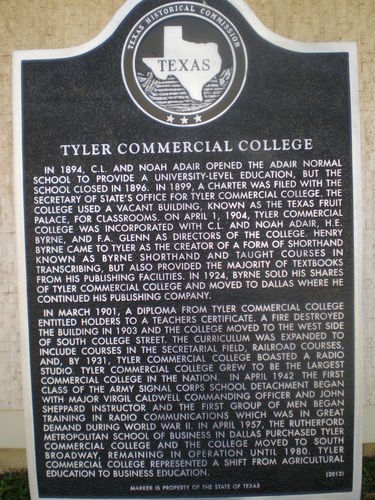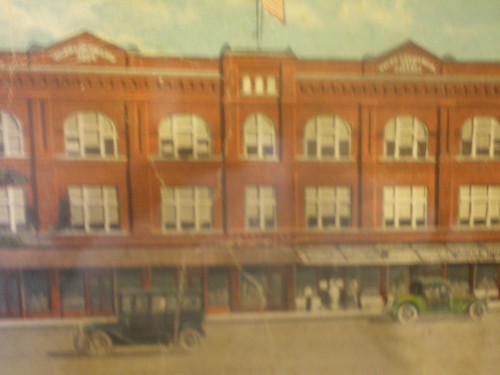.jpg) The Rise and Fall of Tyler Commercial College
The Rise and Fall of Tyler Commercial College
By Marvin Mayer
PART I
From a physical perspective, little more than a commemorative historical marker remains of what was once proclaimed to be the largest commercial college in the United States. While the physical structures have been replaced by a multi-lane drive-thru banking facility, the historical site marker's dedication on March 1, 2014 stirred up memories of a thriving business school for many of its graduates.
Tyler Commercial College's roots go back to 1899. As successor to Tyler College, itself the successor to Grayson County's Whitesboro Teachers Normal College, Tyler Commercial College ("TCC") seized the opportunity to move into an existing 3-story frame building, the former home of the Texas Fruit Palace. Texas Fruit Palace vacated the property in 1896 after declaring bankruptcy. Located at the intersection of Vine and West Front streets, the Fruit Palace building offered sufficient space to meet the College's immediate and future needs; classrooms, administrative offices and ample space to be converted to use as dormitories. But this utopian situation was short lived.
Early on a December morning in 1903, fire completely destroyed the building. Fortunately, there were no serious injuries or fatalities among the students and faculty who, at that time, lived in the second floor dorm rooms. Destruction of the building by no means meant the end of TCC.
Before the last ashes had cooled, arrangements for continuation of classes were under way. Faculty members circulated in the crowd of students and Tylerites watching the devastating fire and advised them the College would open in the Armory Building at 9:00 am Monday. Normal starting time was 8:00 am. Displaced dormitory students were taken into private homes of Tyler citizens, and the total school time lost amounted to one hour.
With the same dedication and rapidity as was demonstrated in locating a temporary facility, the school's trustees tackled the problem of finding a new permanent location for their school. A tract of ground measuring 140 feet deep and 31 feet fronting on South College street somewhat centered between West Elm (to the south) and West Erwin (to the north) seemed perfectly suited for the school's needs. The school, now a bonafide Texas corporation, acquired the desired land from the city of Tyler. Subject to restrictions or conditions noted below, city Trustees conveyed the property to TCC in a document dated April 6, 1904 . Restrictions required the new owners to (a) erect a building which it would maintain as the college for at least 10 years, and (b) during those years, graduate at least 250 bonafide students each year. Needless to say, those conditions were more than satisfied.
A more ideal location for TCC could not have been found. Immediately north of the College building was small building housing the Byrne Publishing Company, publisher of all of the text books used in the college. Built on the south side of the college's 3-story building was the Tyler Carnegie Library building, built in 1904. Some confusion may have existed since the façade of the Carnegie building transom simply proclaimed it "Library"3 with no explanation that it had no connection to TCC.
Although the college survived the depression years, that period of economic depression took its toll. The fading of business colleges across the country was triggered by the nation's anemic economy. Higher education was one of the first casualties. When the nation began to recover, many local schools and junior colleges added business education to their offerings. Some of the skills being taught at this type of school were being replaced by changing technology. At TCC, some of the courses phased out included shorthand, typing, and accounting, almost all of which had become available in public schools. Still, TCC hung on when, in the early WWII years, it established a Signal Corps School Detachment through which some 2,000 hand-picked Army recruits received radio and international Morse Code training. But it was too little, too late.
In the mid 1950s, the school vacated its 3-story building and moved to smaller quarters at 615 South Broadway. Sixty-one years later, the wrecking ball demolished the once magnificent 1904 building.
There's much more to tell about TCC. Please visit this site next month to learn more about the students, faculty, and curriculum as well as more details about the rise and fall of the nation's largest business training school.

